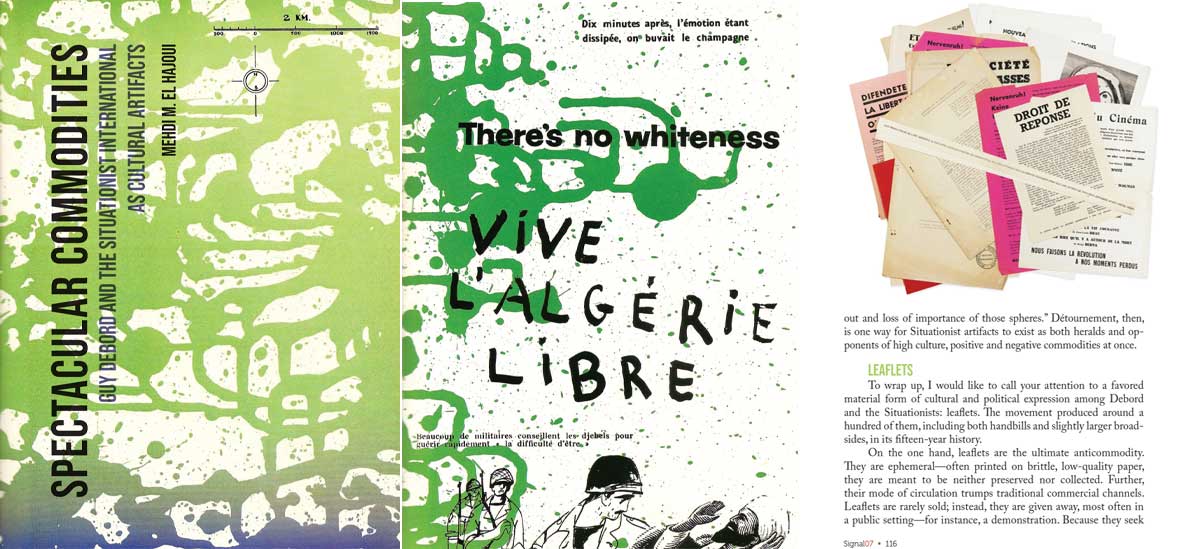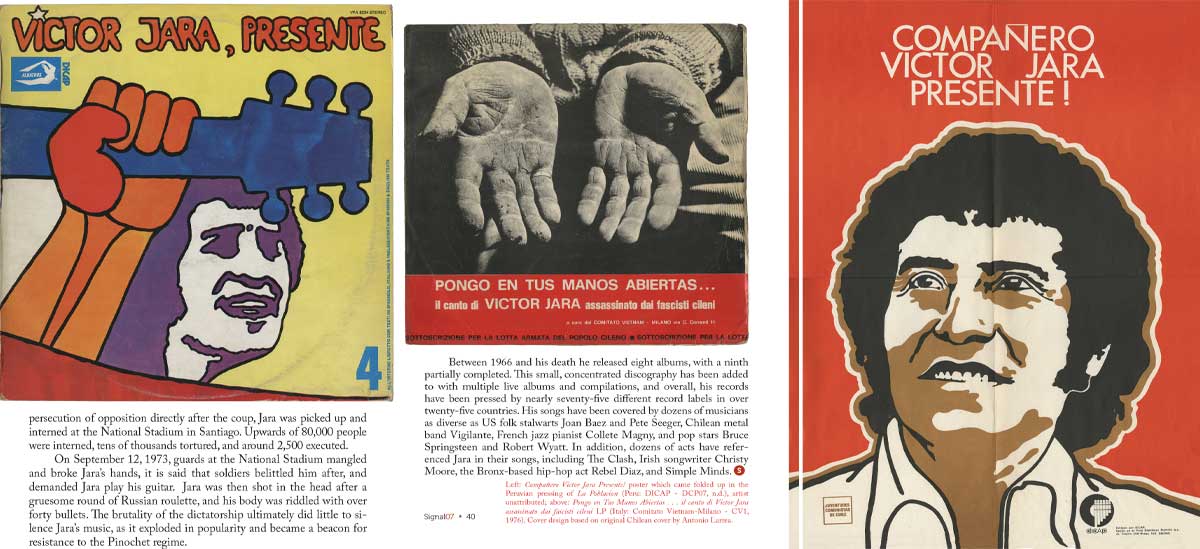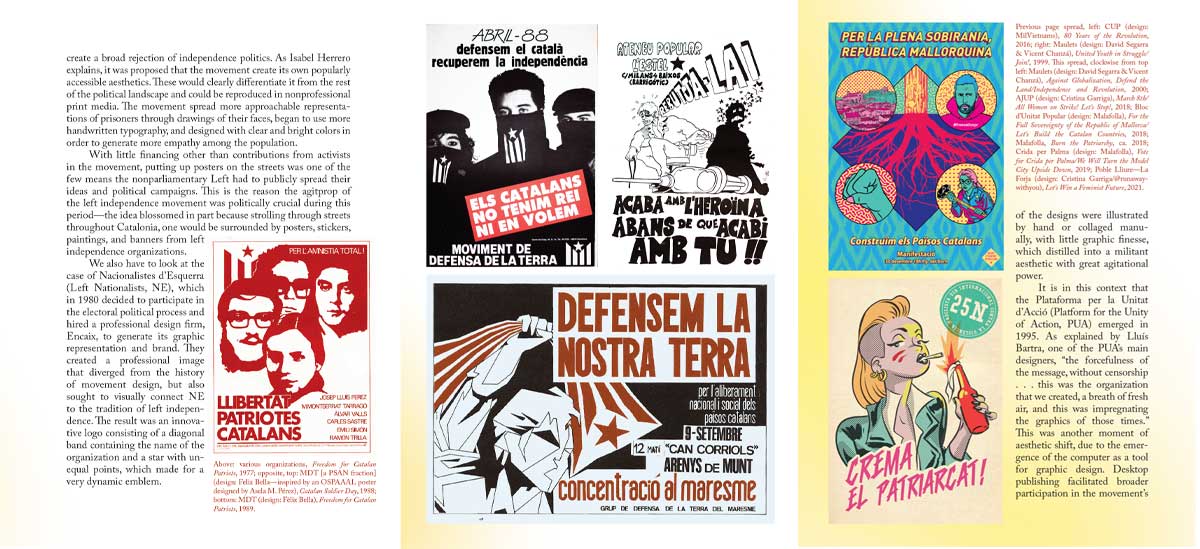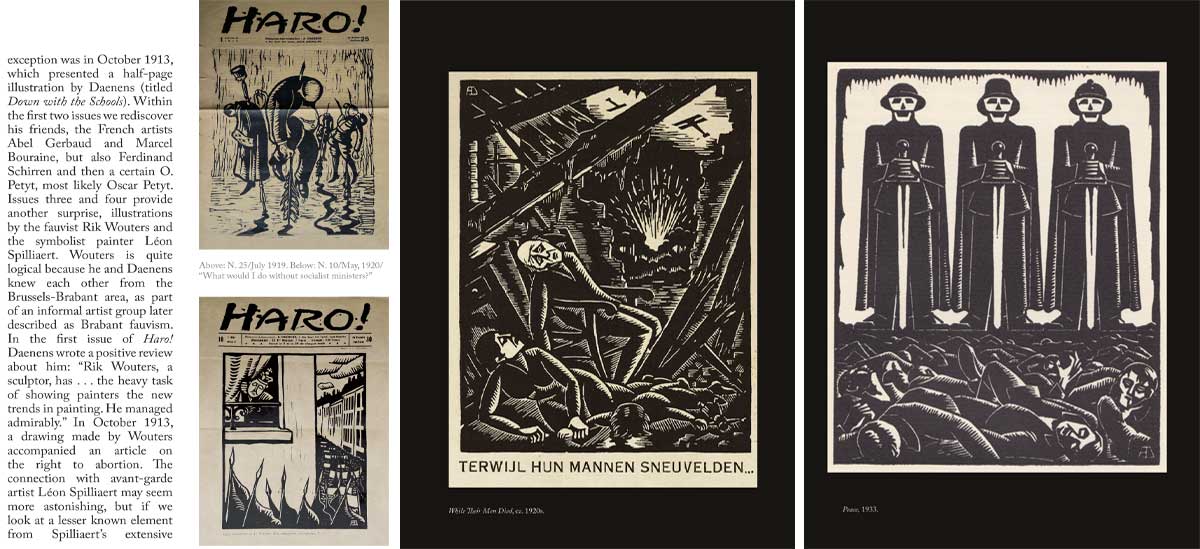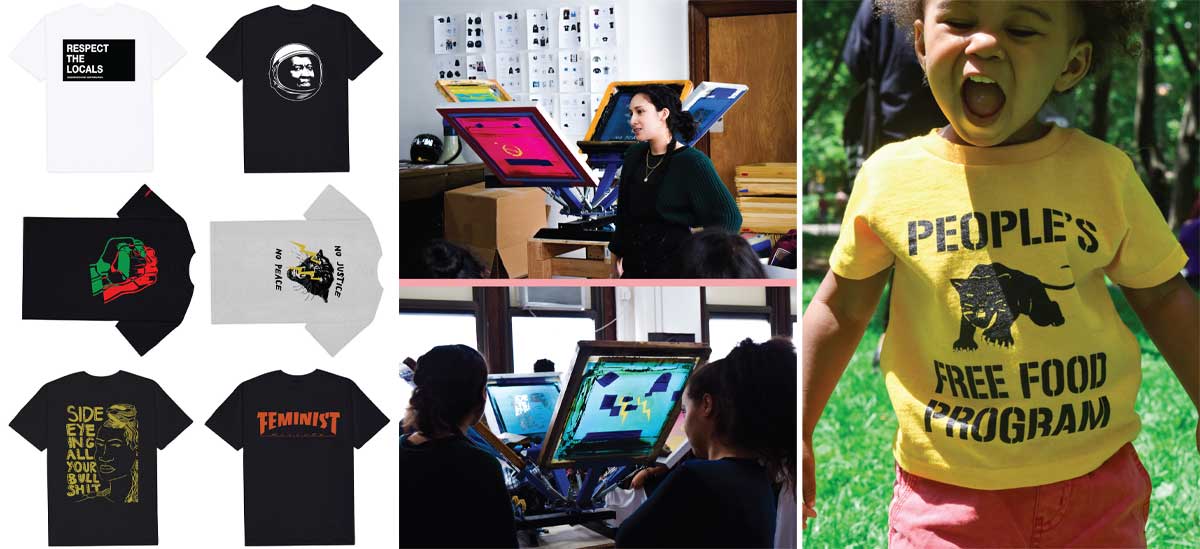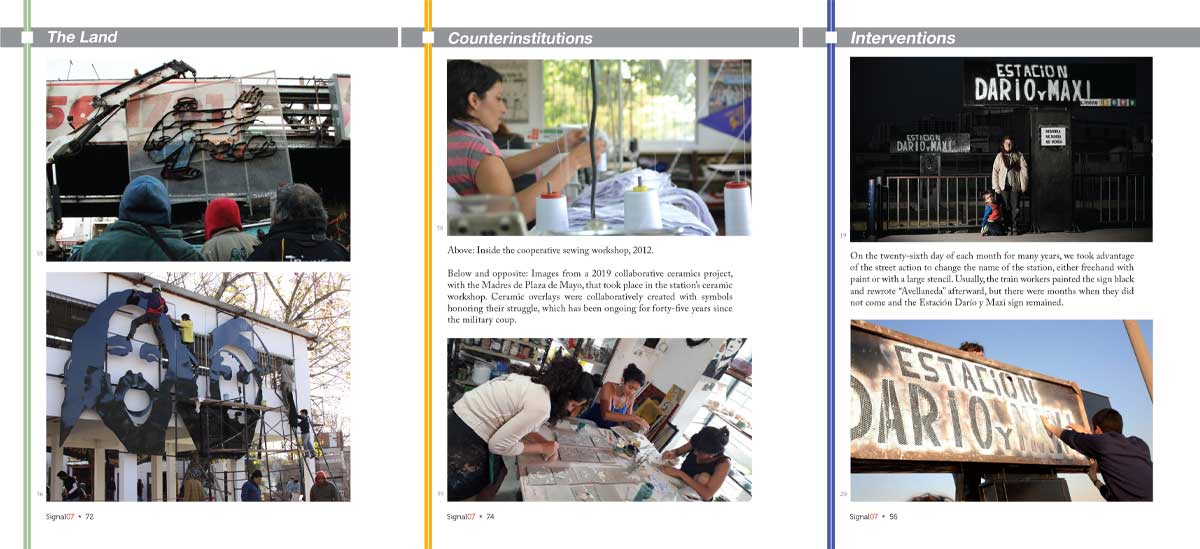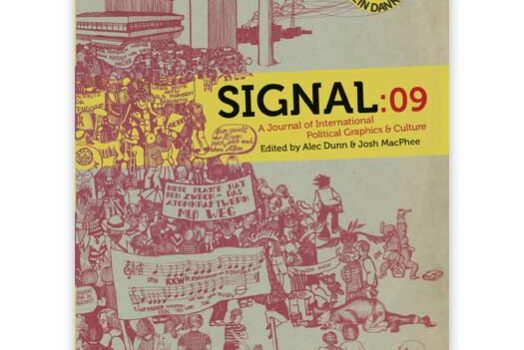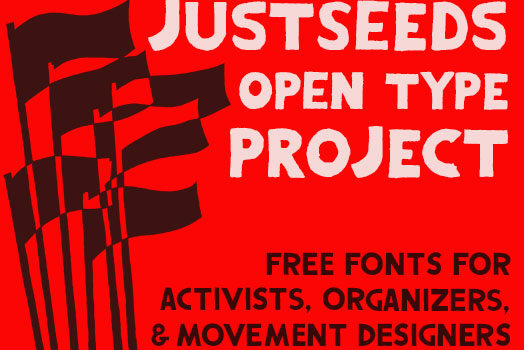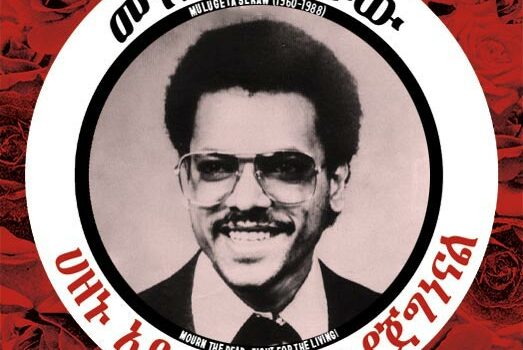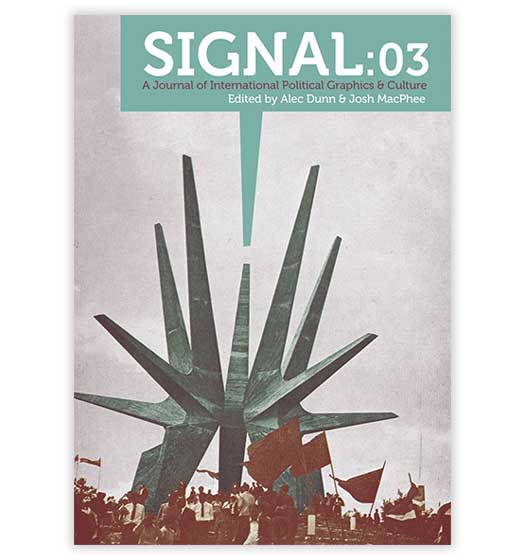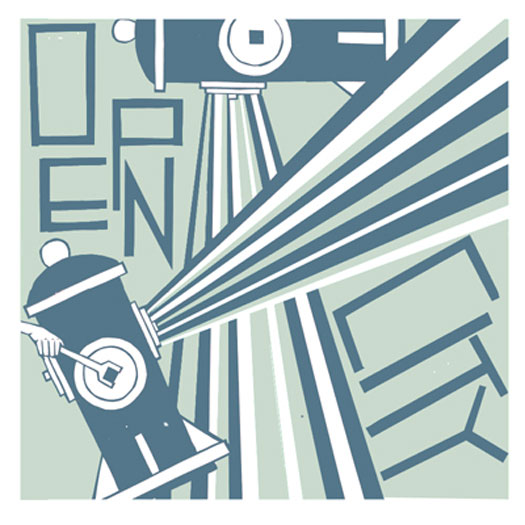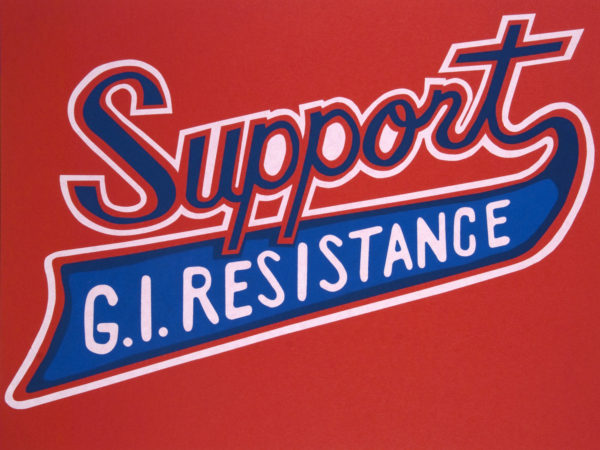Way back in the summer of 2019 Josh MacPhee and I started putting together the new issue of Signal: A Journal of International Political Graphics & Culture, our seventh in the series. We had solidified the content for the issue and began to notify contributors about upcoming deadlines for the writing. Our deadline for a Spring 2020 release was December 2019, and we’d hoped to use September through November of 2019 to start and finish the layout. By December we had most of our content edited but unfortunately only some of the layout completed, so we pushed it back. Historically we have probably missed more deadlines than we’ve made, but usually things work out- we might get pushed into the next publishing cycle but would still usually get copies back early enough that it didn’t feel too tardy. 2020 was different of course. At first covid stunned the publishing world and no one quite knew how to proceed. Then there were massive backlogs at printing houses. Then our cherished publisher switched distributors. All of this kept pushing our print date back and back and back and back. It was with some excitement and relief when a week back I received a box of Signal:07s, almost two years old but fresh from the printer and still smelly with ink. It’s been a fucked up couple of years for everything else, so why not for Signal too?
Anyway- I’m here to talk about the new issue, so let’s start the show!
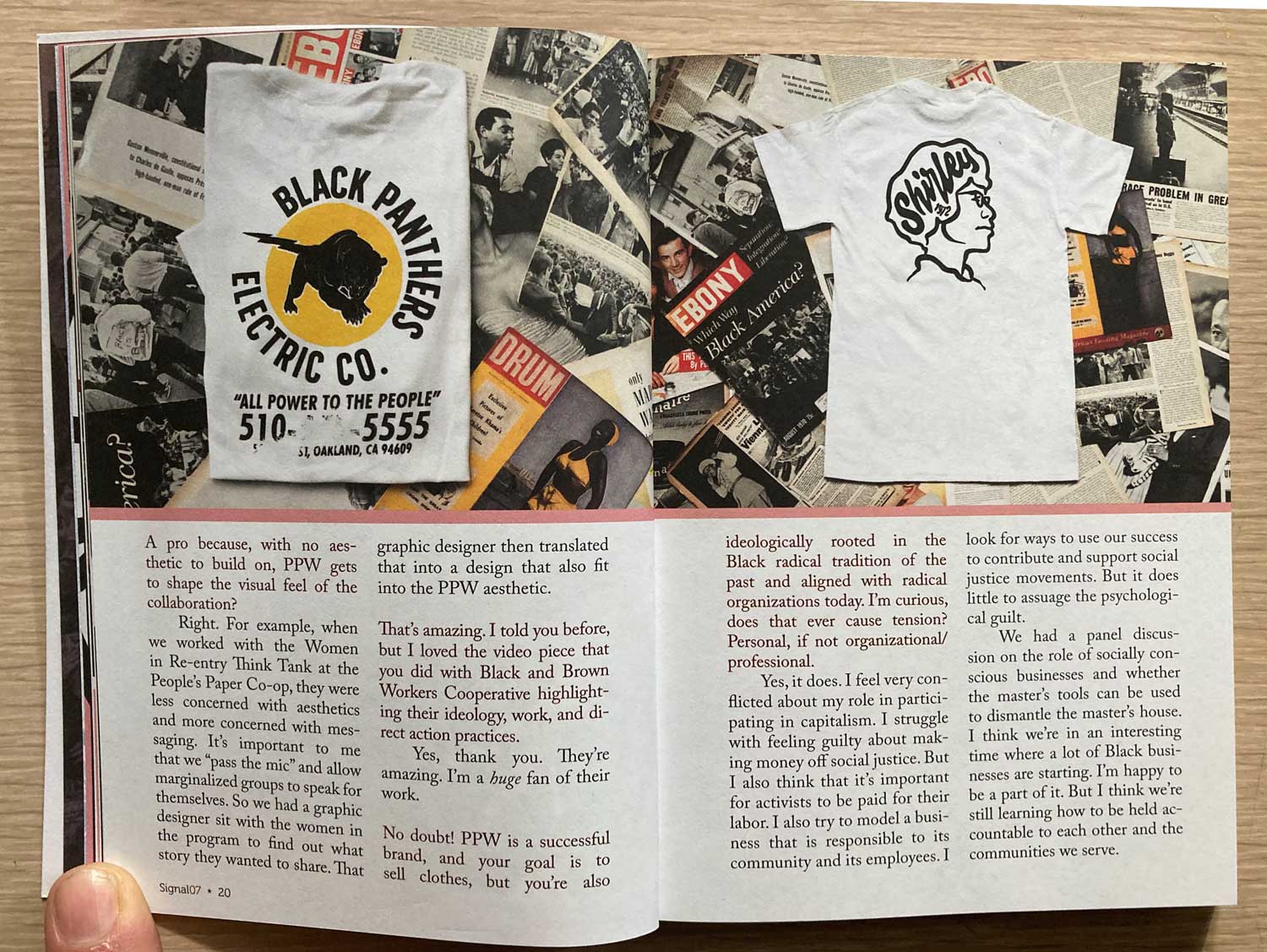
Our first feature for the issue was an interview with Maryam Pugh who is one of the co-founders of Philadelphia Printworks, a radical Black t-shirt company, design firm, and political project. Like a lot of projects these days (including but not limited to Justseeds and Signal) Philadelphia Printworks resists traditional boundaries: Is it a business? A community organization? A media project? ‘Yes’ is the simple and complex answer. I’d been seeing PPW’s shirts on social media, and loved their playfulness with images of Black radicalism (the BPP electric company for one, the image of Octavia Butler in an astronaut’s helmet for another). I admired their sharp design and their visual humor. They draw from the aesthetics of radical and DIY cultures and have a keen sense of the elusive elements that makes a great t-shirt. We were lucky to be put in touch with John Morrison, a podcaster, producer, journalist and DJ from Philadelphia who took up the challenge and interviewed Maryam for this issue. Maryam talks about her history and path to political art making, about how Philadelphia Printworks runs, and about the complexities of carrying on a project like this.

Our second article came from anarchist historian Erik Buelinckx who contributed a biography of the largely forgotten 20th century Belgian artist Albert Daenens. The images in the article mostly come from the journal Haro! which Daenens designed, illustrated, and edited. His work is quite stunning, especially so when exploring the horrors of war and capitalism. Daenens was part of a wave of post WW1 Northern European political printmakers, roughly grouped as expressionists, who championed an evocative (and at times raw) approach to capturing the post-war European landscape via low-cost printmaking. Daenens had some aesthetic similarities to fellow Belgian printmaker Frans Masereel, but Daenens’ work ran darker, with the alienation dialed down and the outrage dialed up. For Signal Erik Buelinckx’s dived deep into Daenens’ history, using extremely scant sources, and created a biography that reveals a complex thinker and activist who was involved in writing, journalism, publishing, criticism, art-making, theatre, and set-design. A bit of a dilettante who died largely forgotten and has remained so. This article puts forward a case for Daenens’ continued relevance.
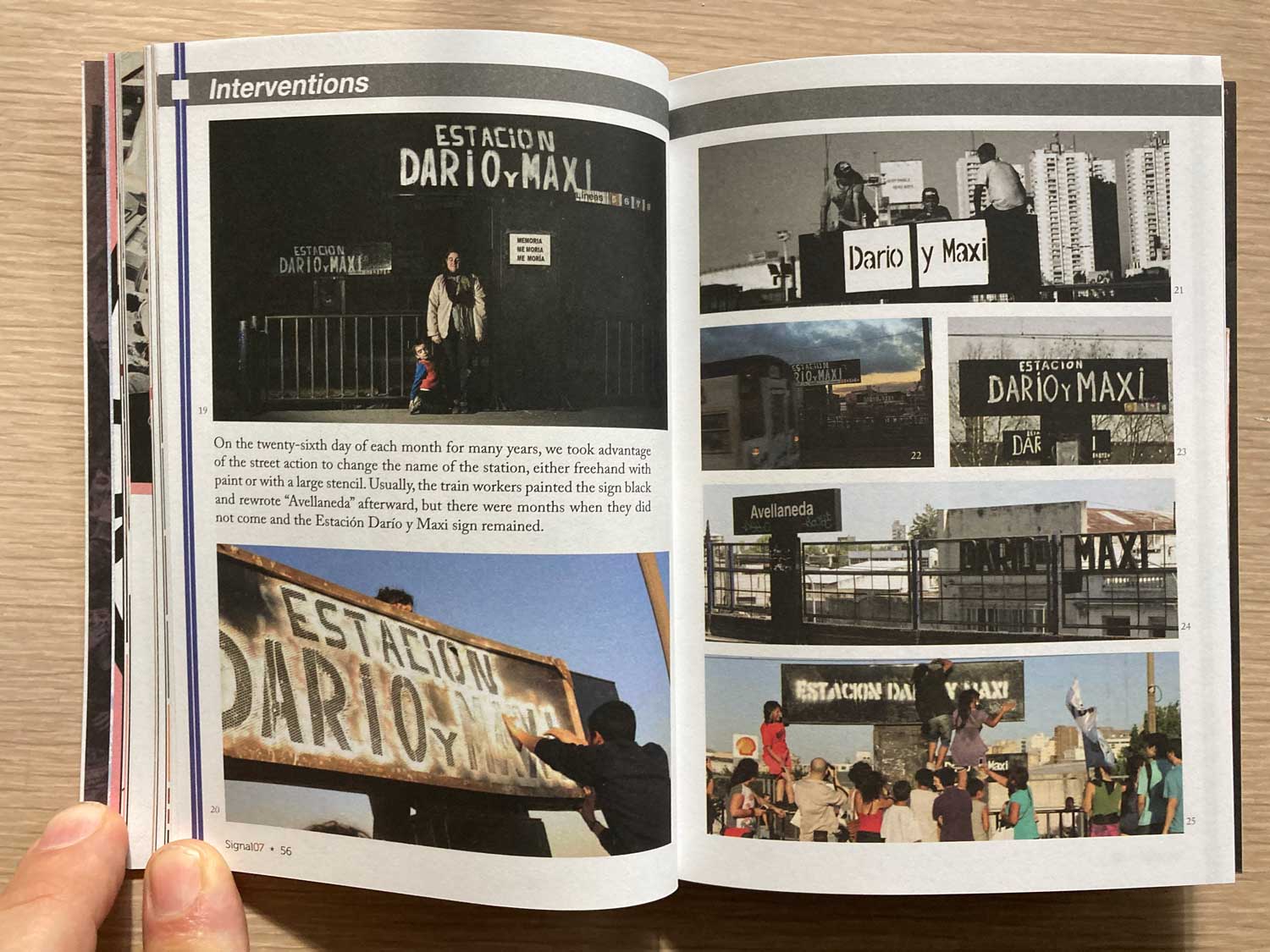
Natalia Revale, an Argentinian artist and activist, supplied us with a documentary history of Darío and Maxi Station, which has been an incredible political project in honor of two young activists (Maxi Kosteki and Darío Santillan) who were killed by police during an anti-austerity mobilization outside of Buenos Aires, in the city of Avellaneda, in 2002. In response, the Avellaneda Train Station became a site of protest, action, and creative resistance. Friends and family, fellow activists in the unemployed movement, as well as artists, graffiti writers, and musicians came together weekly/monthly/yearly to demand justice for their two comrades. Murals were painted by direct action, protest were held there every month, and the stations signs were changed from Avellanada to Estación Darío Y Maxi over and over and over again, for years! Festivals, theatre performances, and art shows were held at the station in honor of the two young men. The activists and the friends and families of Darío and Maxi kept the pressure up for two decades and slowly transformed the station into a site of resistance against state violence and impunity and also a place that joyfully (and often illegally) memorialized these two young men. Natalia Revale, who authored this article, has been heavily involved in several projects there and took on the difficult task of documenting all of this for Signal. I found this to be a really inspiring example of how to wage a long and hard struggle, a struggle with lots of direct confrontation, that also makes room for memory, music, celebration, community-building, and art.
There was such a wealth of material about the transformation of Estación Darío y Maxi that I wish we could have done an entire issue about it– we first cut an article that I wrote to make more room this, then we kept having to cut images from the article itself in order to leave room for other articles in the issue. Even still, this is the longest piece (by page and image count) that we’ve had in Signal with 67 photo credits over 38 pages.
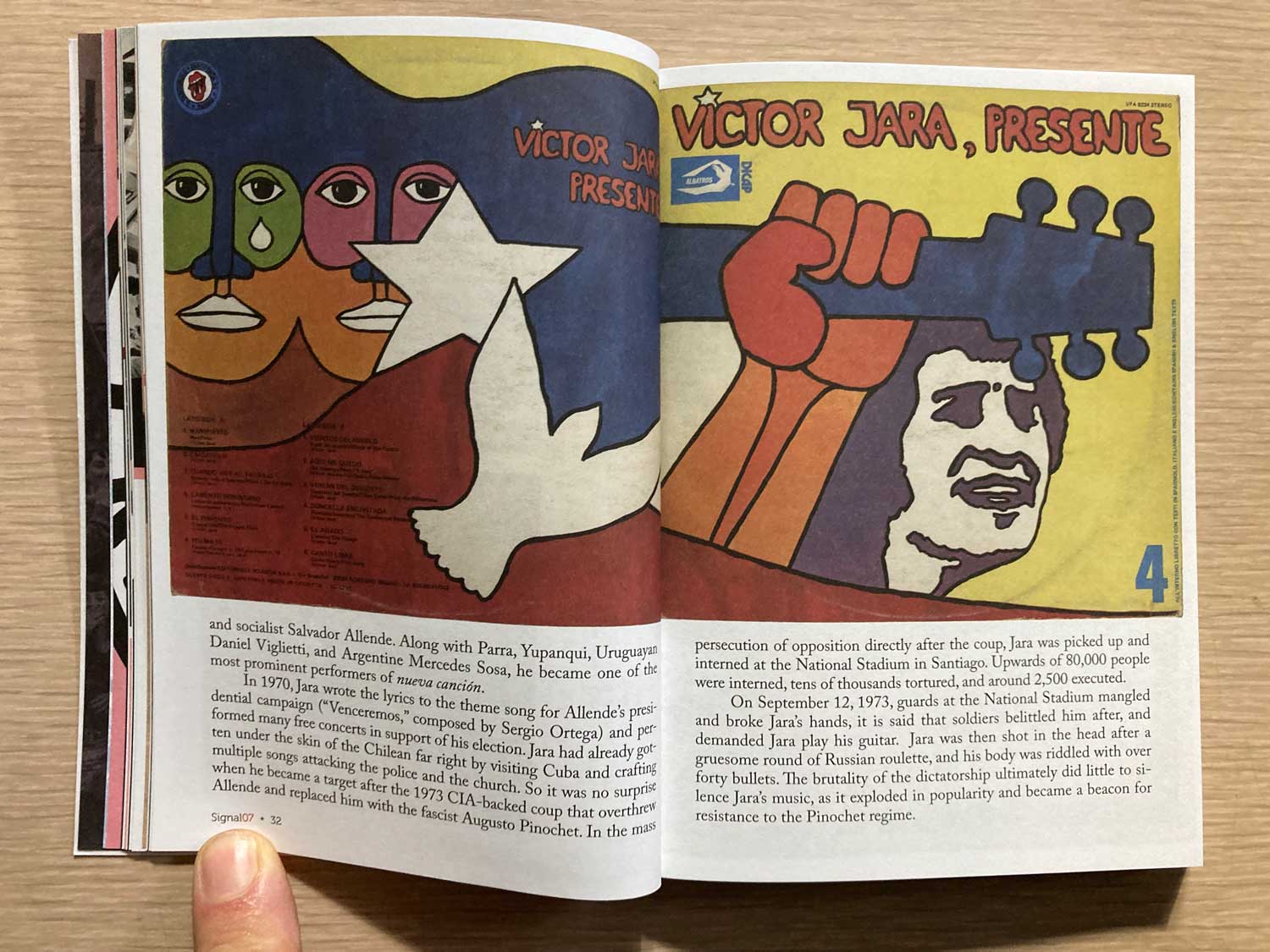
My co-editor Josh MacPhee has been nurturing an obsession with political records and music and especially with political record labels (see his other projects like An Encyclopedia of Political Record Labels as well as the exhibition if a song could be freedom… that he helped organize at Interference Archive). In this issue he writes about the recorded output of Victor Jara, the socialist nuevo cancion musician and singer who may be the most published political musician world-wide with, as Josh notes, records released by over 75 labels from at least 25 countries. As the 1973 right-wing coup in Chile and Jara’s subsequent assassination by soldiers fades from recent memory, Jara’s unique take on both Chilean and modern folk idioms, his lilting voice, complex guitar arrangements, and commitment to the struggle still resonates almost fifty years later. Josh presents a brief biography and documents the international designs of Victor Jara’s records here.

There’s a handful of US based poster makers that are on Signal’s bucket list to have features on, and Malaquías Montoya was probably at the top of that list. If you’ve been looking at political posters as long as we have, Montoya’s images are super-normalized in their brilliance. I’ve seen images of these posters for so long, and they are so well-done, that it’s actually hard to think of them not just appearing as a force of nature but actually being made by a single person. This California artist, muralist, poster maker, activist, and educator has produced a stunning body of work in his eight decades on the planet, and has been involved with numerous projects each deserving of their own articles. Bill Berkowitz, a Bay Area based journalist, conducted a long-form interview with Montoya about his origins and development as an artist, and also about his current projects and views of the world. In Signal we used about 30 or so images of his but there are hundreds that we didn’t use (look at his website for a more complete overview of Montoya’s work). I encourage taking some time with these images and remembering that he thought of how to represent an action or struggle, and then followed it through and drew the images, drew the lettering, balanced the composition and color choices, and then separated the colors for printing and finally printed the things. He really is a master designer, poster-maker, political thinker, artist, and technician. We are honored to have him and his work on the earth with us.

Mehdi el Hajoui is a collector of books and book arts with a specific focus on the output of the Situationist International (SI). For this issue of Signal he adapted a presentation he gave on the art books of the SI, especially the publications created by Guy Debord and Asger Jorn. The Situationist International was stridently political, but had a complicated relationship with the political world, the art-world, and with collectors. The situationists were violently anti-art industry, but also produced documents that were aggressively fetishizable and inscrutable. They were not peoples’ artists, but they were radicals who challenged the art world and the status quo. Mehdi leans into these complexities, noting the care and intention behind the SI’s printed output, their international reach, and humorously positions the beginning and end of the essay around the multi-million dollar blue-plate bidding war over Guy Debord’s personal archives.

Way back in Signal:01 Melanie Cervantes said this about designing political posters, “Politically, I ask am I developing my ideas in a vacuum, or are they shaped by larger ideas? My ideas are never only shaped by me.” There’s a push/pull with graphics and political movements, sometimes cultural work can move the conversation forward and other times it follows trends happening on the ground- we can see that push/pull, that conversation between designers and movements, happening in Jordi Padró’s broad overview of Left Catalan posters and graphics in Signal:07. From the rough illegalist posters of the 60s and 70s that celebrated militant and militarized fighters, to the influence of punk and squatter cultures on designs in the late 80s and 90s, to the opening up of aesthetics (at the turn of the 21st century) with brighter colors that explored a more exuberant, intersectional, resistance. This is the only article that may have truly suffered from our printing delay. Jordi Padró wrote this piece shortly after Catalonia voted to secede from Spain in 2017 and during the severe repression of the leaders of that movement that occurred in 2018 and 2019. Two years out from that, with all of the madness of the world between now and 2019, the struggle for Catalan Independence has been pushed out of the spotlight (at least stateside). Regardless, he presents a compelling history of how the cultural work of a movement can shift the movement’s culture.
Otherwise, with this issue’s more history oriented pieces, the delayed timing of our publishing was an inconvenience but didn’t really effect the relevance of the subject matter. Josh’s feature on Victor Jara, Mehdi’s piece on the politics and economics of the art books of the SI, Erik Buelinckx’s historical biography of Albert Daenens, and Bill Berkowitz’s interview with Malaquias Montoya are all as relevant today as they were in 2019 (I am not assigning Montoya’s work to history as he still continues to make compelling images, but the interview is largely historical in nature).
Of the other articles about current issues, they have aged surprisingly well- John Morrison’s interview with Philadelphia Printworks’ co-founder Maryam Pugh touches on a multitude of topics including the legacy of Black radical design, activism and fashion, and the politics of running a business ethically. In the last two years PPW have new designs out and plenty of new projects and collaborations but the spirit of the project remains the same. Natalia Revale documented the decades long struggle to turn a commuter rail station just outside of Buenos Aires into a site of activism and memory by sustained grassroots pressure and activism. In light of the many struggles responding to police violence and white supremacy in this country, this article offers deep inspiration on fighting a long battle and keeping the pressure up.
* * *
Is there an overall theme for this issue? As with previous issues, by intention there is not, by accident there is. In this issue we highlight many cultural projects and artists that weren’t contained by simple borders, Albert Daenens worked in multiple disciplines but held true to his beliefs, aesthetics, and values across them; Philadelphia Printworks has created something new and interesting in its structure, principles, and outlook; Estación Darío y Maxi is a functioning stop on a metro line and also a site of resistance and creativity; Victor Jara’s music was deeply rooted in Chilean idioms but took root worldwide as his music was suppressed in his home country. Signal itself is neither a serial nor book, our publishing schedule is erratic. We are scholarly but not academic. Activist but not didactic. We endeavor to keep open to new ways of making political art. Things don’t fit easily into boxes. Let’s celebrate that a little.
* * *
When we started Signal we’d hoped to publish yearly. It’s now been 12 years and only 7 issues, so we’re a little behind! In the beginning we wanted to share the incredible range of political graphics happening worldwide. In 12 years lots has changed, access to international work has increased, but thoughtful writing and research remains moribund. Our original inspiration was kind of like, “Holy shit! Everyone needs to see this incredible work!” while now we’re still inspired by the work that goes in here, but with less vigor. Maybe we’re just getting older? We’ve talked about changing the format, working on theme issues, expanding the editorial board, a number of ideas to mix things up. Nothing has really stuck yet, the structure and future of Signal remains a work in progress. We question the relevance of what we are doing. As Signal sporadically chews up lots of our time, we both wonder if it is the best place to be putting so much energy. In the past we have leaned on the momentum of the project, one issue gets done and we start working on the next. This publishing delay screwed up our already skewed publishing schedule. So, if you like Signal we’d love to hear from you. If you have an idea for an article–pitch it to us. If you work in a school or a university, see if you can get the library to carry it.
Finally, some appreciations. PM Press has been our constant companion during this project, so a huge thanks to them for their patience and perseverance, especially over the tumultuous 2020 publishing season. And I would like to offer an especially big and overdue thanks to our deepest reader and most astute fact checker, PM’s copy editor, Gregory Nipper. His extensive knowledge and long relationship with us have consistently elevated this project.
Signal:07 is available here.
Back issues-
Signal:01 is available HERE.
Signal:02 is available HERE.
Signal:03 is available HERE.
Signal:04 is available HERE.
Signal:05 is available HERE.
Signal:06 is available HERE.
You can also purchase the first six issues as a set HERE.
